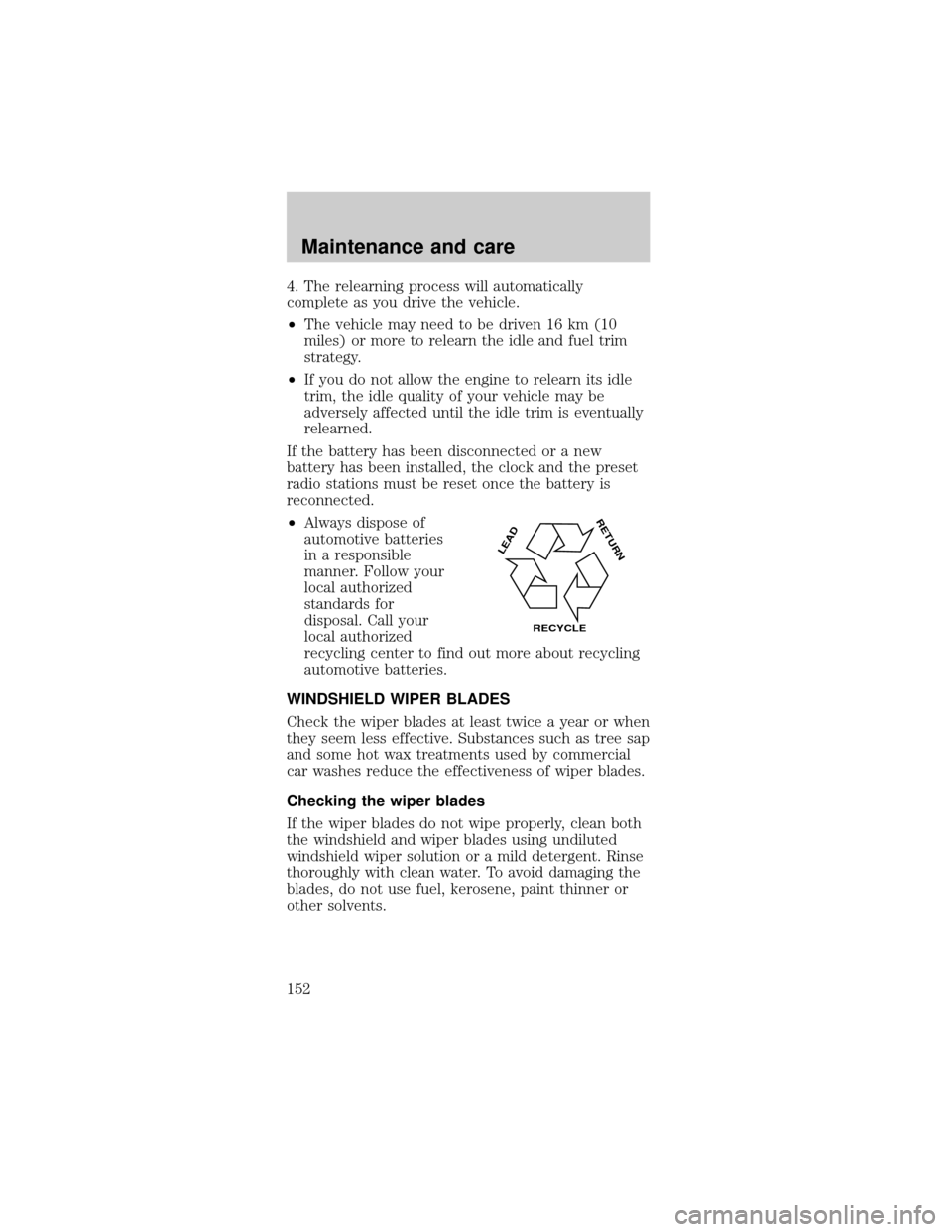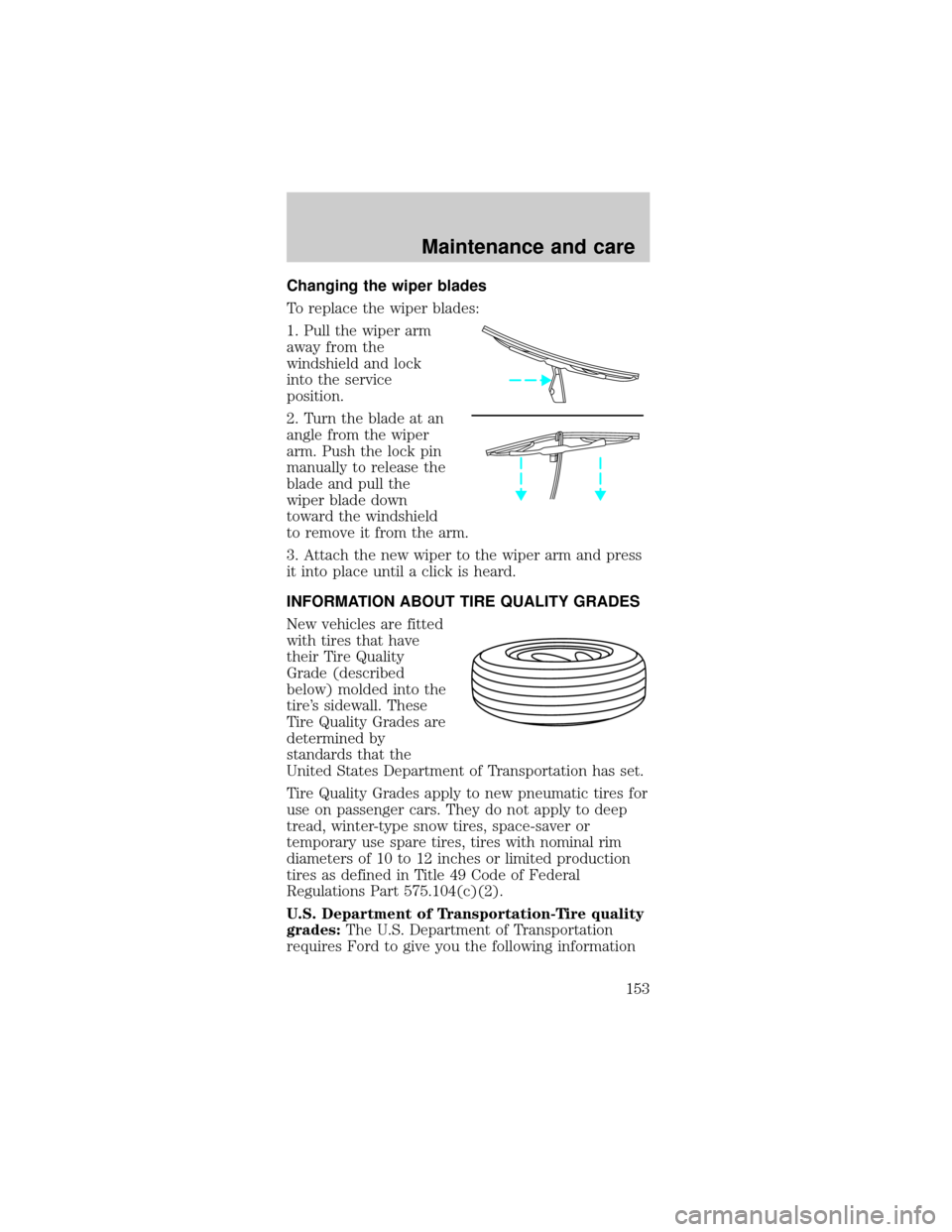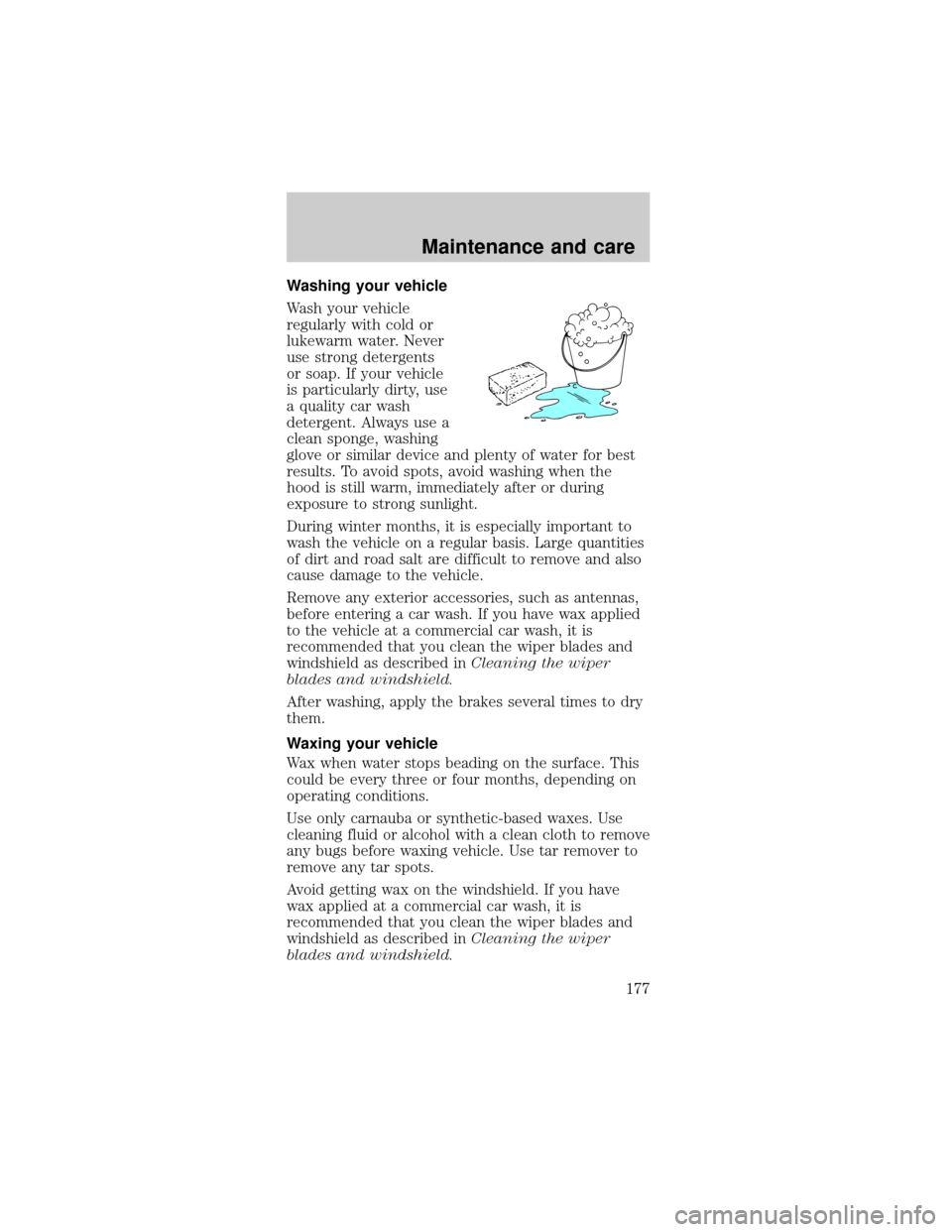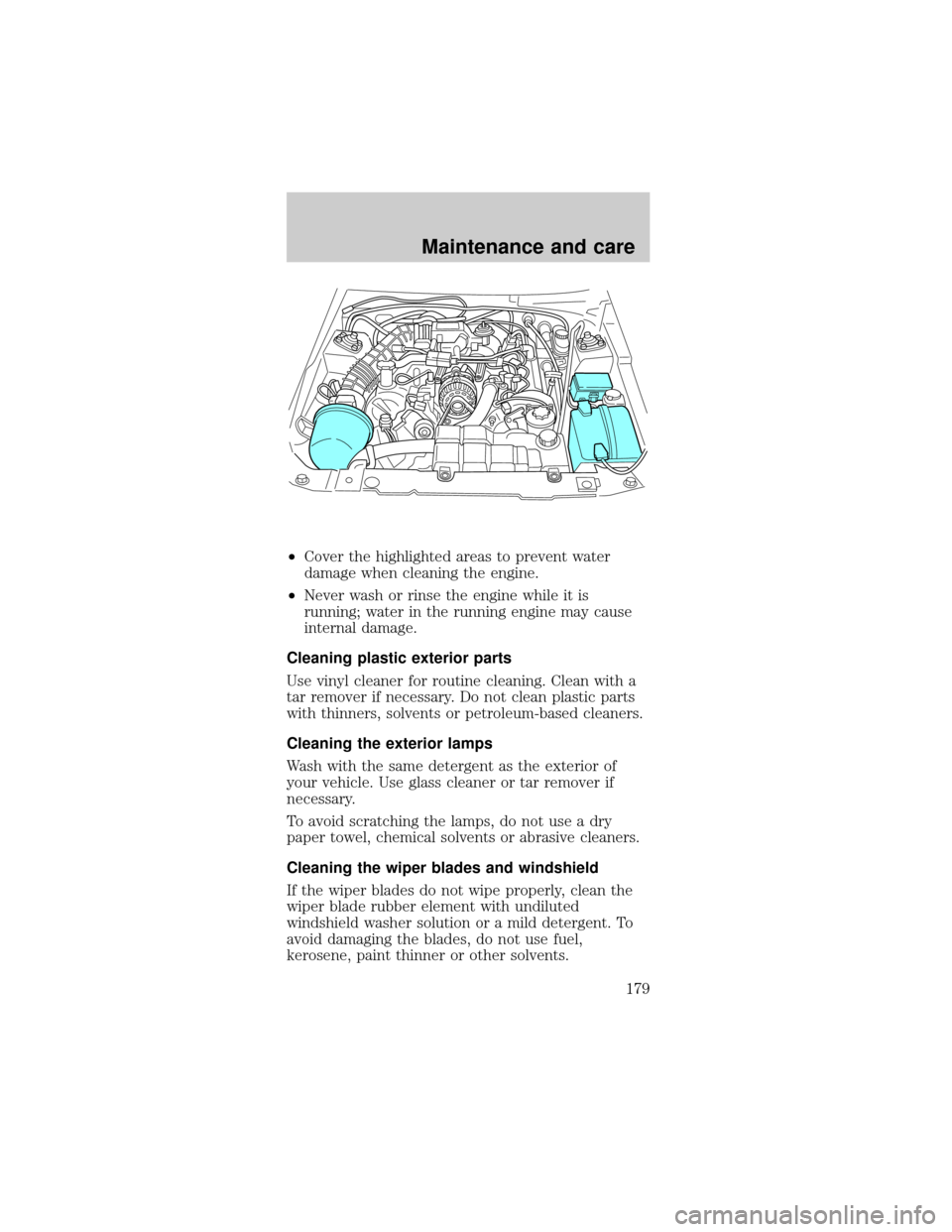1999 FORD MUSTANG wiper blades
[x] Cancel search: wiper bladesPage 152 of 216

4. The relearning process will automatically
complete as you drive the vehicle.
²The vehicle may need to be driven 16 km (10
miles) or more to relearn the idle and fuel trim
strategy.
²If you do not allow the engine to relearn its idle
trim, the idle quality of your vehicle may be
adversely affected until the idle trim is eventually
relearned.
If the battery has been disconnected or a new
battery has been installed, the clock and the preset
radio stations must be reset once the battery is
reconnected.
²Always dispose of
automotive batteries
in a responsible
manner. Follow your
local authorized
standards for
disposal. Call your
local authorized
recycling center to find out more about recycling
automotive batteries.
WINDSHIELD WIPER BLADES
Check the wiper blades at least twice a year or when
they seem less effective. Substances such as tree sap
and some hot wax treatments used by commercial
car washes reduce the effectiveness of wiper blades.
Checking the wiper blades
If the wiper blades do not wipe properly, clean both
the windshield and wiper blades using undiluted
windshield wiper solution or a mild detergent. Rinse
thoroughly with clean water. To avoid damaging the
blades, do not use fuel, kerosene, paint thinner or
other solvents.
LEAD
RETURN
RECYCLE
Maintenance and care
152
Page 153 of 216

Changing the wiper blades
To replace the wiper blades:
1. Pull the wiper arm
away from the
windshield and lock
into the service
position.
2. Turn the blade at an
angle from the wiper
arm. Push the lock pin
manually to release the
blade and pull the
wiper blade down
toward the windshield
to remove it from the arm.
3. Attach the new wiper to the wiper arm and press
it into place until a click is heard.
INFORMATION ABOUT TIRE QUALITY GRADES
New vehicles are fitted
with tires that have
their Tire Quality
Grade (described
below) molded into the
tire's sidewall. These
Tire Quality Grades are
determined by
standards that the
United States Department of Transportation has set.
Tire Quality Grades apply to new pneumatic tires for
use on passenger cars. They do not apply to deep
tread, winter-type snow tires, space-saver or
temporary use spare tires, tires with nominal rim
diameters of 10 to 12 inches or limited production
tires as defined in Title 49 Code of Federal
Regulations Part 575.104(c)(2).
U.S. Department of Transportation-Tire quality
grades:The U.S. Department of Transportation
requires Ford to give you the following information
Maintenance and care
153
Page 177 of 216

Washing your vehicle
Wash your vehicle
regularly with cold or
lukewarm water. Never
use strong detergents
or soap. If your vehicle
is particularly dirty, use
a quality car wash
detergent. Always use a
clean sponge, washing
glove or similar device and plenty of water for best
results. To avoid spots, avoid washing when the
hood is still warm, immediately after or during
exposure to strong sunlight.
During winter months, it is especially important to
wash the vehicle on a regular basis. Large quantities
of dirt and road salt are difficult to remove and also
cause damage to the vehicle.
Remove any exterior accessories, such as antennas,
before entering a car wash. If you have wax applied
to the vehicle at a commercial car wash, it is
recommended that you clean the wiper blades and
windshield as described inCleaning the wiper
blades and windshield.
After washing, apply the brakes several times to dry
them.
Waxing your vehicle
Wax when water stops beading on the surface. This
could be every three or four months, depending on
operating conditions.
Use only carnauba or synthetic-based waxes. Use
cleaning fluid or alcohol with a clean cloth to remove
any bugs before waxing vehicle. Use tar remover to
remove any tar spots.
Avoid getting wax on the windshield. If you have
wax applied at a commercial car wash, it is
recommended that you clean the wiper blades and
windshield as described inCleaning the wiper
blades and windshield.
Maintenance and care
177
Page 179 of 216

²Cover the highlighted areas to prevent water
damage when cleaning the engine.
²Never wash or rinse the engine while it is
running; water in the running engine may cause
internal damage.
Cleaning plastic exterior parts
Use vinyl cleaner for routine cleaning. Clean with a
tar remover if necessary. Do not clean plastic parts
with thinners, solvents or petroleum-based cleaners.
Cleaning the exterior lamps
Wash with the same detergent as the exterior of
your vehicle. Use glass cleaner or tar remover if
necessary.
To avoid scratching the lamps, do not use a dry
paper towel, chemical solvents or abrasive cleaners.
Cleaning the wiper blades and windshield
If the wiper blades do not wipe properly, clean the
wiper blade rubber element with undiluted
windshield washer solution or a mild detergent. To
avoid damaging the blades, do not use fuel,
kerosene, paint thinner or other solvents.
Maintenance and care
179
Page 180 of 216

If the wiper still does not wipe properly, this could
be caused by substances on the windshield such as
tree sap and some hot wax treatments used by
commercial car washes. Clean the outside of the
windshield with a non-abrasive cleanser such as the
non-abrasive Bon-Amitpowder. Rinse thoroughly
with clean water.Do notuse abrasive cleansers on
glass as they may cause scratches. The windshield is
clean if beads do not form when you rinse it with
water. The windshield and wiper blades should be
cleaned on a regular basis, and blades or rubber
elements replaced when worn.
Cleaning the instrument panel
Clean with a damp cloth, then dry with a dry cloth.
Avoid cleaner or polish that increases the gloss of
the upper portion of the instrument panel. The dull
finish in this area helps protect the driver from
undesirable windshield reflection.
Cleaning the interior fabric
Remove dust and loose dirt with a whisk broom or a
vacuum cleaner. Remove fresh spots immediately. Do
not use household or glass cleaners. These agents
can stain and discolor the fabric. Use a mild soap
and water solution if necessary.
Cleaning leather seats (if equipped)
To clean, simply use a soft cloth dampened with
water and a mild soap. Wipe the leather again with a
damp cloth to remove soap residue. Dry with a soft
cloth. For tougher soiling concerns, Ford
recommends using the Deluxe Leather Care Kit
F8AZ-19G253±AA, which is available from your Ford
Dealer. This mild cleaner and special pad, cleans the
leather and maintains its natural beauty. Follow the
instructions on the cleaner label. Regular cleaning of
your leather upholstery helps maintain its resiliency
and color.
Maintenance and care
180
Page 208 of 216

safety belts ............ 181
washing .................. 177
waxing ................... 177
wheels .................... 178
windows ................ 181
wiper blades .......... 179
Clock ..................... 33,38
Clutch
adjusting ................ 139
operation
while driving ......... 102
recommended
shift speeds ........... 103
Console ...................... 52
Controls
power seat ............... 65
Convertible ................ 53
cleaning ................. 181
installation
of the boot .............. 54
lowering the
convertible top ........ 53
raising the
convertible top ........ 56
Coolant ...... 141,143,144
checking
and adding ............ 142
low coolant light ..... 10
refill
capacities ........ 144,183
specifications . 185,188
Customer Assistance 191
Ford accessories for
your vehicle .......... 200
Ford Extended
Service Plan .......... 192
Getting assistance
outside the U.S.
and Canada ........... 199
Getting roadside
assistance .............. 191Getting the service
you need ............... 193
Ordering additional
owner's literature . 205
The Dispute
Settlement Board . 195
Defrost
rear window ............ 17
Dipstick
engine oil ............... 134
Driving under special
conditions
through water ....... 111
Emergencies, roadside
jump-starting ........ 123
Emission control
system ...................... 168
Engine ...................... 188
check engine/service
engine soon light ...... 8
coolant ................... 141
idle speed control . 150
lubrication
specifications . 185,188
refill capacities ...... 183
service points . 133,134
starting after a
collision ................. 112
Engine block heater . 90
Engine oil ................ 134
checking and
adding ............. 134,136
dipstick .................. 134
filter,
specifications . 137,182
recommendations . 137
refill
capacities ........ 134,183
specifications ........ 134
137,185,188
Exhaust fumes .......... 91
Floor mats ................. 52
Index
208
Page 212 of 216

Traction control ........ 95
active light .............. 10
Traction-lok
rear axle .................. 105
Transmission
automatic
operation ................. 97
fluid, checking
and adding
(automatic) ........... 146
fluid, checking and
adding (manual) ... 149
fluid,
refill capacities ...... 183
lubricant
specifications ........ 188
manual operation .. 102
Trip odometer ........... 14
Trunk
remote release ... 44,58
Turn signal ............. 6,44
Vehicle dimensions . 188
Vehicle Identification
Number (VIN) ......... 190Vehicle loading ........ 106
Ventilating
your vehicle ............... 91
Warning chimes ......... 11
Warning lights
(see Lights) ................. 6
Washer fluid ............ 140
Water,
Driving through ....... 111
Wheels
anti-theft
lug nuts ................. 123
Windows
power ....................... 50
Windshield washer
fluid and wipers
checking
and cleaning .......... 152
operation ................. 44
replacing
wiper blades .......... 153
Wrecker towing ....... 128
Index
212